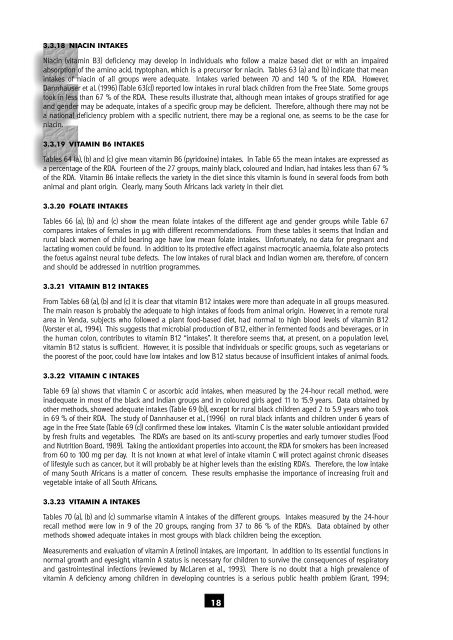the nutritional status of - Health Systems Trust
the nutritional status of - Health Systems Trust
the nutritional status of - Health Systems Trust
Create successful ePaper yourself
Turn your PDF publications into a flip-book with our unique Google optimized e-Paper software.
3.3.18 NIACIN INTAKES<br />
Niacin (vitamin B3) deficiency may develop in individuals who follow a maize based diet or with an impaired<br />
absorption <strong>of</strong> <strong>the</strong> amino acid, tryptophan, which is a precursor for niacin. Tables 63 (a) and (b) indicate that mean<br />
intakes <strong>of</strong> niacin <strong>of</strong> all groups were adequate. Intakes varied between 70 and 140 % <strong>of</strong> <strong>the</strong> RDA. However,<br />
Dannhauser et al. (1996) (Table 63(c)) reported low intakes in rural black children from <strong>the</strong> Free State. Some groups<br />
took in less than 67 % <strong>of</strong> <strong>the</strong> RDA. These results illustrate that, although mean intakes <strong>of</strong> groups stratified for age<br />
and gender may be adequate, intakes <strong>of</strong> a specific group may be deficient. Therefore, although <strong>the</strong>re may not be<br />
a national deficiency problem with a specific nutrient, <strong>the</strong>re may be a regional one, as seems to be <strong>the</strong> case for<br />
niacin.<br />
3.3.19 VITAMIN B6 INTAKES<br />
Tables 64 (a), (b) and (c) give mean vitamin B6 (pyridoxine) intakes. In Table 65 <strong>the</strong> mean intakes are expressed as<br />
a percentage <strong>of</strong> <strong>the</strong> RDA. Fourteen <strong>of</strong> <strong>the</strong> 27 groups, mainly black, coloured and Indian, had intakes less than 67 %<br />
<strong>of</strong> <strong>the</strong> RDA. Vitamin B6 intake reflects <strong>the</strong> variety in <strong>the</strong> diet since this vitamin is found in several foods from both<br />
animal and plant origin. Clearly, many South Africans lack variety in <strong>the</strong>ir diet.<br />
3.3.20 FOLATE INTAKES<br />
Tables 66 (a), (b) and (c) show <strong>the</strong> mean folate intakes <strong>of</strong> <strong>the</strong> different age and gender groups while Table 67<br />
compares intakes <strong>of</strong> females in µg with different recommendations. From <strong>the</strong>se tables it seems that Indian and<br />
rural black women <strong>of</strong> child bearing age have low mean folate intakes. Unfortunately, no data for pregnant and<br />
lactating women could be found. In addition to its protective effect against macrocytic anaemia, folate also protects<br />
<strong>the</strong> foetus against neural tube defects. The low intakes <strong>of</strong> rural black and Indian women are, <strong>the</strong>refore, <strong>of</strong> concern<br />
and should be addressed in nutrition programmes.<br />
3.3.21 VITAMIN B12 INTAKES<br />
From Tables 68 (a), (b) and (c) it is clear that vitamin B12 intakes were more than adequate in all groups measured.<br />
The main reason is probably <strong>the</strong> adequate to high intakes <strong>of</strong> foods from animal origin. However, in a remote rural<br />
area in Venda, subjects who followed a plant food-based diet, had normal to high blood levels <strong>of</strong> vitamin B12<br />
(Vorster et al., 1994). This suggests that microbial production <strong>of</strong> B12, ei<strong>the</strong>r in fermented foods and beverages, or in<br />
<strong>the</strong> human colon, contributes to vitamin B12 “intakes”. It <strong>the</strong>refore seems that, at present, on a population level,<br />
vitamin B12 <strong>status</strong> is sufficient. However, it is possible that individuals or specific groups, such as vegetarians or<br />
<strong>the</strong> poorest <strong>of</strong> <strong>the</strong> poor, could have low intakes and low B12 <strong>status</strong> because <strong>of</strong> insufficient intakes <strong>of</strong> animal foods.<br />
3.3.22 VITAMIN C INTAKES<br />
Table 69 (a) shows that vitamin C or ascorbic acid intakes, when measured by <strong>the</strong> 24-hour recall method, were<br />
inadequate in most <strong>of</strong> <strong>the</strong> black and Indian groups and in coloured girls aged 11 to 15.9 years. Data obtained by<br />
o<strong>the</strong>r methods, showed adequate intakes (Table 69 (b)), except for rural black children aged 2 to 5.9 years who took<br />
in 69 % <strong>of</strong> <strong>the</strong>ir RDA. The study <strong>of</strong> Dannhauser et al., (1996) on rural black infants and children under 6 years <strong>of</strong><br />
age in <strong>the</strong> Free State (Table 69 (c)) confirmed <strong>the</strong>se low intakes. Vitamin C is <strong>the</strong> water soluble antioxidant provided<br />
by fresh fruits and vegetables. The RDA’s are based on its anti-scurvy properties and early turnover studies (Food<br />
and Nutrition Board, 1989). Taking <strong>the</strong> antioxidant properties into account, <strong>the</strong> RDA for smokers has been increased<br />
from 60 to 100 mg per day. It is not known at what level <strong>of</strong> intake vitamin C will protect against chronic diseases<br />
<strong>of</strong> lifestyle such as cancer, but it will probably be at higher levels than <strong>the</strong> existing RDA’s. Therefore, <strong>the</strong> low intake<br />
<strong>of</strong> many South Africans is a matter <strong>of</strong> concern. These results emphasise <strong>the</strong> importance <strong>of</strong> increasing fruit and<br />
vegetable intake <strong>of</strong> all South Africans.<br />
3.3.23 VITAMIN A INTAKES<br />
Tables 70 (a), (b) and (c) summarise vitamin A intakes <strong>of</strong> <strong>the</strong> different groups. Intakes measured by <strong>the</strong> 24-hour<br />
recall method were low in 9 <strong>of</strong> <strong>the</strong> 20 groups, ranging from 37 to 86 % <strong>of</strong> <strong>the</strong> RDA’s. Data obtained by o<strong>the</strong>r<br />
methods showed adequate intakes in most groups with black children being <strong>the</strong> exception.<br />
Measurements and evaluation <strong>of</strong> vitamin A (retinol) intakes, are important. In addition to its essential functions in<br />
normal growth and eyesight, vitamin A <strong>status</strong> is necessary for children to survive <strong>the</strong> consequences <strong>of</strong> respiratory<br />
and gastrointestinal infections (reviewed by McLaren et al., 1993). There is no doubt that a high prevalence <strong>of</strong><br />
vitamin A deficiency among children in developing countries is a serious public health problem (Grant, 1994;<br />
18
















